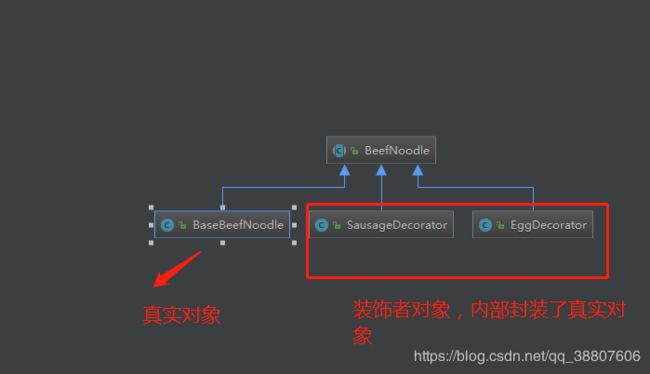简单的装饰者模式
装饰者模式主要用来扩展功能的,不会改变原来对象的功能,只做扩展
版本一:
代码如下:
public abstract class BeefNoodle {
protected abstract String getMsg();
protected abstract int getPrice();
}
public class BaseBeefNoodle extends BeefNoodle {
protected String getMsg(){
return "牛肉面";
}
public int getPrice(){
return 5;
}
}
public class EggDecorator extends BeefNoodle {
private BeefNoodle beefNoodle;
public EggDecorator(BeefNoodle beefNoodle) {
this.beefNoodle = beefNoodle;
}
//增强的功能(基于真实对象上)
protected String getMsg() {
return beefNoodle.getMsg() + "+1个鸡蛋";
}
//增强的功能(基于真实对象上)
protected int getPrice() {
return beefNoodle.getPrice() + 1;
}
}
private BeefNoodle beefNoodle;
public SausageDecorator(BeefNoodle beefNoodle) {
this.beefNoodle = beefNoodle;
}
protected String getMsg() {
return beefNoodle.getMsg() + "+1根香肠";
}
protected int getPrice() {
return beefNoodle.getPrice() + 2;
}
测试代码:
public class MyTest {
public static void main(String[] args) {
BeefNoodle beefNoodle;
//买一碗牛肉
beefNoodle = new BaseBeefNoodle();
//加一个鸡蛋
beefNoodle = new EggDecorator(beefNoodle);
//加根香肠
beefNoodle = new SausageDecorator(beefNoodle);
System.out.println(beefNoodle.getMsg()+"总价:"+beefNoodle.getPrice());
}
}
效果如下:
版本二:
①根据策略模式获取对应的策略对象
②计算价格用具体的某一个装饰者对象去计算,因为会需要面的基本信息,所以作为构造参数传进来(代表这个对象是被增强的目标),此外各个装饰者对象还扩展了自己的功能,比如 混合了鸡蛋和香肠的类,方法就有三个参数(代表碗数量,鸡蛋数量,烤肠数量)
类图:
代码如下:
public abstract class BeefNoodle {
protected abstract String getMsg(Integer amount);
protected abstract int getPrice(Integer amount);
}
public class BaseBeefNoodle extends BeefNoodle {
//amount 牛肉面数量
protected String getMsg(Integer amount){
return "牛肉面 * "+String.valueOf(amount);
}
//amount 牛肉面数量
public int getPrice(Integer amount){
return 5*amount;
}
}
public class EggDecorator extends BeefNoodle {
private BeefNoodle beefNoodle;
public EggDecorator(BeefNoodle beefNoodle) {
this.beefNoodle = beefNoodle;
}
protected String getMsg(Integer eggs) {
return beefNoodle.getMsg(1) + "加"+String.valueOf(eggs)+"个鸡蛋";
}
protected int getPrice(Integer eggs) {
return beefNoodle.getPrice(1) + 1*eggs;
}
protected String getMsg(Integer noodles,Integer eggs) {
return beefNoodle.getMsg(noodles) + "加"+String.valueOf(eggs)+"个鸡蛋";
}
protected int getPrice(Integer noodles ,Integer eggs) {
return beefNoodle.getPrice(noodles) + 1*eggs;
}
}
public class SausageDecorator extends BeefNoodle {
private BeefNoodle beefNoodle;
public SausageDecorator(BeefNoodle beefNoodle) {
this.beefNoodle = beefNoodle;
}
protected String getMsg(Integer sausages) {
return beefNoodle.getMsg(1) + "加"+String.valueOf(sausages)+"根香肠";
}
protected int getPrice(Integer sausages) {
return beefNoodle.getPrice(1) + 2*sausages;
}
protected String getMsg(Integer noodles ,Integer sausages) {
return beefNoodle.getMsg(sausages) + "加"+String.valueOf(sausages)+"根香肠";
}
protected int getPrice(Integer noodles ,Integer sausages) {
return beefNoodle.getPrice(noodles) + 1*sausages;
}
}
public class EggsAndSausageDecorator extends BeefNoodle {
private BeefNoodle beefNoodle;
public EggsAndSausageDecorator(BeefNoodle beefNoodle) {
this.beefNoodle = beefNoodle;
}
protected String getMsg(Integer sausages) {
//return beefNoodle.getMsg(1) + "加"+String.valueOf(sausages)+"根香肠";
return "";
}
protected int getPrice(Integer sausages) {
//return beefNoodle.getPrice(1) + 2*sausages;
return 0;
}
protected String getMsg(Integer noodles ,Integer eggs,Integer sausages) {
return beefNoodle.getMsg(sausages) + "加"+String.valueOf(eggs)+"个鸡蛋"+"加"+String.valueOf(sausages)+"根香肠";
}
protected int getPrice(Integer noodles,Integer eggs,Integer sausages) {
return beefNoodle.getPrice(noodles) +1*eggs +2*sausages;
}
// 策略模式,获得不同的策略对象,具体的计算方式是在各个策略对象(装饰者对象)实现的
public class Strategy {
public static final String ONLY_NOODLE = "Noodle";
public static final String WITH_EGGS = "Eggs";
public static final String WITH_SAUSAGES = "Sausages";
public static final String WITH_EGGS_AND_SAUSAGES = "EggsAndSausages";
private static Map noodleStrategy = new HashMap();
static{
BeefNoodle beefNoodle = new BaseBeefNoodle();
noodleStrategy.put(ONLY_NOODLE,beefNoodle);
noodleStrategy.put(WITH_EGGS,new EggDecorator(beefNoodle));
noodleStrategy.put(WITH_SAUSAGES,new SausageDecorator(beefNoodle));
noodleStrategy.put(WITH_EGGS_AND_SAUSAGES,new EggsAndSausageDecorator(beefNoodle));
}
public static BeefNoodle get(String noodleKey){
if(!noodleStrategy.containsKey(noodleKey)){
return noodleStrategy.get(ONLY_NOODLE);
}
return noodleStrategy.get(noodleKey);
}
}
测试类:
public class MyTest {
public static void main(String[] args) {
//选择不同的策略
//一碗牛肉面
BeefNoodle onlyBeefNoodle = Strategy.get(Strategy.ONLY_NOODLE);
System.out.println("只来一碗牛肉面"+onlyBeefNoodle.getMsg(1)+"价格为:"+ String.valueOf(onlyBeefNoodle.getPrice(1)));
//两碗面
System.out.println("只来两碗牛肉面"+onlyBeefNoodle.getMsg(2)+"价格为:"+ String.valueOf(onlyBeefNoodle.getPrice(2)));
// 策略模式选择加 鸡蛋的 策略; 要用子类的方法,所以需要强转下
EggDecorator beefNoodleWithEggs = (EggDecorator)Strategy.get(Strategy.WITH_EGGS);
System.out.println("只来一碗牛肉面加一个鸡蛋 "+beefNoodleWithEggs.getMsg(1,1)+"价格为:"+ String.valueOf(beefNoodleWithEggs.getPrice(1,1)));
System.out.println("只来一碗牛肉面加两个鸡蛋 "+beefNoodleWithEggs.getMsg(1,2)+"价格为:"+ String.valueOf(beefNoodleWithEggs.getPrice(1,2)));
System.out.println("只来两碗碗牛肉面加两个鸡蛋 "+beefNoodleWithEggs.getMsg(2,2)+"价格为:"+ String.valueOf(beefNoodleWithEggs.getPrice(2,2)));
// 策略模式选择加 香肠的 策略; 要用子类的方法,所以需要强转下
SausageDecorator beefNoodleWithSausage = (SausageDecorator)Strategy.get(Strategy.WITH_SAUSAGES);
System.out.println("只来一碗牛肉面加一个香肠 "+beefNoodleWithSausage.getMsg(1,1)+"价格为:"+ String.valueOf(beefNoodleWithSausage.getPrice(1,1)));
System.out.println("只来一碗牛肉面加两个香肠 "+beefNoodleWithSausage.getMsg(1,2)+"价格为:"+ String.valueOf(beefNoodleWithSausage.getPrice(1,2)));
System.out.println("只来两碗碗牛肉面共加两个香肠 "+beefNoodleWithSausage.getMsg(2,2)+"价格为:"+ String.valueOf(beefNoodleWithSausage.getPrice(2,2)));
//策略模式选择加 鸡蛋和香肠
EggsAndSausageDecorator beefNoodleWithEggsAndSausages = (EggsAndSausageDecorator)Strategy.get(Strategy.WITH_EGGS_AND_SAUSAGES);
System.out.println("只来一碗牛肉面加一个鸡蛋一个香肠 "+beefNoodleWithEggsAndSausages.getMsg(1,1,1)+"价格为:"+ String.valueOf(beefNoodleWithEggsAndSausages.getPrice(1,1,1)));
System.out.println("只来一碗牛肉面加两个鸡蛋两个香肠 "+beefNoodleWithEggsAndSausages.getMsg(1,2,2)+"价格为:"+ String.valueOf(beefNoodleWithEggsAndSausages.getPrice(1,4,4)));
System.out.println("只来两碗碗牛肉面各加两个鸡蛋两个香肠 "+beefNoodleWithEggsAndSausages.getMsg(2,4,4)+"价格为:"+ String.valueOf(beefNoodleWithEggsAndSausages.getPrice(2,4,4)));
}
}
测试结果:
只来一碗牛肉面牛肉面 * 1价格为:5
只来两碗牛肉面牛肉面 * 2价格为:10
只来一碗牛肉面加一个鸡蛋 牛肉面 * 1加1个鸡蛋价格为:6
只来一碗牛肉面加两个鸡蛋 牛肉面 * 1加2个鸡蛋价格为:7
只来两碗碗牛肉面加两个鸡蛋 牛肉面 * 2加2个鸡蛋价格为:12
只来一碗牛肉面加一个香肠 牛肉面 * 1加1根香肠价格为:6
只来一碗牛肉面加两个香肠 牛肉面 * 2加2根香肠价格为:7
只来两碗碗牛肉面共加两个香肠 牛肉面 * 2加2根香肠价格为:12
只来一碗牛肉面加一个鸡蛋一个香肠 牛肉面 * 1加1个鸡蛋加1根香肠价格为:8
只来一碗牛肉面加两个鸡蛋两个香肠 牛肉面 * 2加2个鸡蛋加2根香肠价格为:17
只来两碗碗牛肉面各加两个鸡蛋两个香肠 牛肉面 * 4加4个鸡蛋加4根香肠价格为:22





